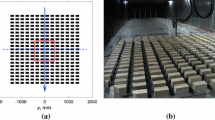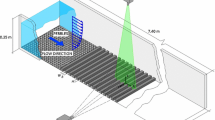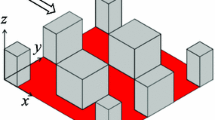Abstract
Practically all extant work on flows over obstacle arrays, whether laboratory experiments or numerical modelling, is for cases where the oncoming wind is normal to salient faces of the obstacles. In the field, however, this is rarely the case. Here, simulations of flows at various directions over arrays of cubes representing typical urban canopy regions are presented and discussed. The computations are of both direct numerical simulation and large-eddy simulation type. Attention is concentrated on the differences in the mean flow within the canopy region arising from the different wind directions and the consequent effects on global properties such as the total surface drag, which can change very significantly—by up to a factor of three in some circumstances. It is shown that for a given Reynolds number the typical viscous forces are generally a rather larger fraction of the pressure forces (principally the drag) for non-normal than for normal wind directions and that, dependent on the surface morphology, the average flow direction deep within the canopy can be largely independent of the oncoming wind direction. Even for regular arrays of regular obstacles, a wind direction not normal to the obstacle faces can in general generate a lateral lift force (in the direction normal to the oncoming flow). The results demonstrate this and it is shown how computations in a finite domain with the oncoming flow generated by an appropriate forcing term (e.g. a pressure gradient) then lead inevitably to an oncoming wind direction aloft that is not aligned with the forcing term vector.
Similar content being viewed by others
References
Barlow JF, Belcher SE (2002) A wind tunnel model for quantifying fluxes in the urban boundary layer. Boundary-Layer Meteorol 104: 131–150
Belcher S (2005) Mixing and transport in urban areas. Philos Trans Roy Soc A363: 2947–2968
Bezpalcova K (2006) Physical modelling of flow and diffusion in urban canopy. PhD thesis, Charles University, Prague
Biltoft C (2001) Customer report for mock urban setting test. Tech. Rep. WDTC-FR-01-121, U.S. Army Dugway Proving Ground, Dugway, UT
Branford S, Coceal O, Thomas TG, Belcher SE (2011) Dispersion of a point-source release of a passive scalar through an urban-like array for different wind directions. Boundary-Layer Meteorol 139: 367–394
Castro IP, Robins AG (1977) The flow around a surface-mounted cube in uniform and turbulent streams. J Fluid Mech 79: 307–335
Cheng H, Castro IP (2002) Near-wall flow over urban-like roughness. Boundary-Layer Meteorol 104: 229–259
Claus J (2011) Wind direction effects on urban flows. PhD thesis, Engineering Sciences, University of Southampton
Coceal O, Belcher SE (2004) A canopy model of mean winds through urban areas. Q J Roy Meteorol Soc 139: 1349–1372
Coceal O, Thomas TG, Castro IP, Belcher SE (2006) Mean flow and turbulence statistics over groups of urban-like cubical obstacles. Boundary-Layer Meteorol 121: 491–519
Davidson MJ, Mylne KR, Jones CD, Phillips JC, Perkins RJ, Fung JCH, Hunt JCR (1995) Plume dispersion through large groups of obstacles—a field investigation. Atmos Environ 29: 3245–3256
Dejoan A, Santiago J, Martilli A, Martin F, Pinelli A (2010) Comparison between large-eddy simulation and reynolds-averaged navier stokes computations for the must field experiment part ii: effects of incident wind angle deviation on the mean flow and plume dispersion. Boundary-Layer Meteorol 135: 133–150
Dobre A, Arnold SJ, Smalley RJ, Boddy JWD, Barlow JF, Tomlin AS, Belcher SE (2005) Flow field measurements in the proximity of an urban intersection in London, UK. Atmos Environ 39: 4647–4657
Hagishima A, Tanimoto J, Nagayama K, Meno S (2009) Aerodynamic parameters of regular arrays of rectangular blocks with various geometries. Boundary-Layer Meteorol 132: 227–315
Hanna SR, Thranian S, Carissimo B, MacDonald RW, Lohner R (2002) Comparisons of model simulations with observations of mean flow and turbulence within simple obstacle arrays. Atmos Environ 36: 5067–5079
Hanna SR, Brown MJ, Camelli FE, Chan ST, Coirier WJ, Hansen OR, Huber AH, Kim S, Reynolds RM (2006) Detailed simulations of atmospheric flow and dispersion in downtown Manhattan. Bull Am Meteorol Soc 87: 1713–1726
Inagaki A, Castillo M, Yamashita Y, Kanda M, Takimoto H (2012) Large-eddy simulations study of coherent flow structures within a cubical canopy. Boundary-Layer Meteorol. doi:10.1007/s10546-011-9671-8
Jackson PS (1981) On the displacement height in the logarithmic velocity profile. J Fluid Mech 111: 15–25
Kanda M, Kanega M, Kawai T, Moriwaki R (2007) Roughness lengths for momentum and heat derived from outdoor urban scale models. J Appl Meteorol Climatol 46: 1067–1079
Kastner-Kline P, Rotach MW (2005) Mean flow and turbulence characteristics in an urban roughness sublayer. Boundary-Layer Meteorol 111: 55–84
Kim J, Baik J (2004) A numerical study of the effects of ambient wind direction on flow and dispersion in urban street canyons using the RNG k–epsilon model. Atmos Environ 38: 3039–3048
Leonardi S, Castro IP (2010) Channel flow over large cube roughness: a DNS study. J Fluid Mech 651: 519–539
Perry SG, Heist DK, Thompson RS, Snyder WH, Lawson RE (2004) Wind tunnel simulation of flow and pollutant dispersal around the World Trade Centre site. Environ Manager February:31–34
Rotach MW (1993) Turbulence close to a rough urban surface, Part I: Reynolds stress. Boundary-Layer Meteorol 65: 1–28
Roth M (2000) Review of atmospheric turbulence over cities. Q J Roy Meteorol Soc 126: 941–990
Takimoto H, Sato A, Barlow JF, Moriwaki R, Inagaki A, Onomura S, Kanda M (2011) Particle image velocimetry measurements of turbulent flow within outdoor and indoor urban scale models and flushing motions in urban canopy layers. Boundary-Layer Meteorol 140: 295–314
Wood C, Arnold S, Balogen A, Barlow J, Belcher S, Britter R, Cheng H, Dobre A, Lingard J, Martin D, Neophytou M, Petersson F, Robins A, Shallcross D, Smalley R, Tate J, Tomlin A, White I (2009) Dispersion experiments in central London. Bull Am Meteorol Soc 90: 956–965
Xie ZT (2011) Modelling street-scale flow and dispersion in realistic winds—towards coupling with mesoscale meteorological models. Boundary-Layer Meteorol 141: 53–75
Xie ZT, Castro IP (2006) LES and RANS for turbulent flow over arrays of wall-mounted obstacles. Flow Turbul Combust 76: 291–392
Xie ZT, Coceal O, Castro IP (2008) Large eddy simulation of flows over random urban-like obstacles. Boundary-Layer Meteorol 129: 1–23
Yamartino RJ, Wiegand G (1986) Development and evaluation of simple models for the flow, turbulence and pollutant fields within an urban street canyon. Atmos Environ 20: 2137–2156
Yao YF, Thomas TG, Sandham ND, Williams JJR (2001) Direct numerical simulation of turbulent flow over a rectangular trailing edge. Theor Comput Fluid Dyn 14: 337–358
Yee E, Biltoft C (2004) Concentration fluctuation measurements in a plume dispersing through a regular array of obstacles. Boundary-Layer Meteorol 111: 363–415
Yoshizawa A (1986) Statistical theory for compressible turbulent shear flows, with the application to subgrid scale modelling. Phys Fluids 29: 2152–2164
Author information
Authors and Affiliations
Corresponding author
Rights and permissions
About this article
Cite this article
Claus, J., Coceal, O., Thomas, T.G. et al. Wind-Direction Effects on Urban-Type Flows. Boundary-Layer Meteorol 142, 265–287 (2012). https://doi.org/10.1007/s10546-011-9667-4
Received:
Accepted:
Published:
Issue Date:
DOI: https://doi.org/10.1007/s10546-011-9667-4




